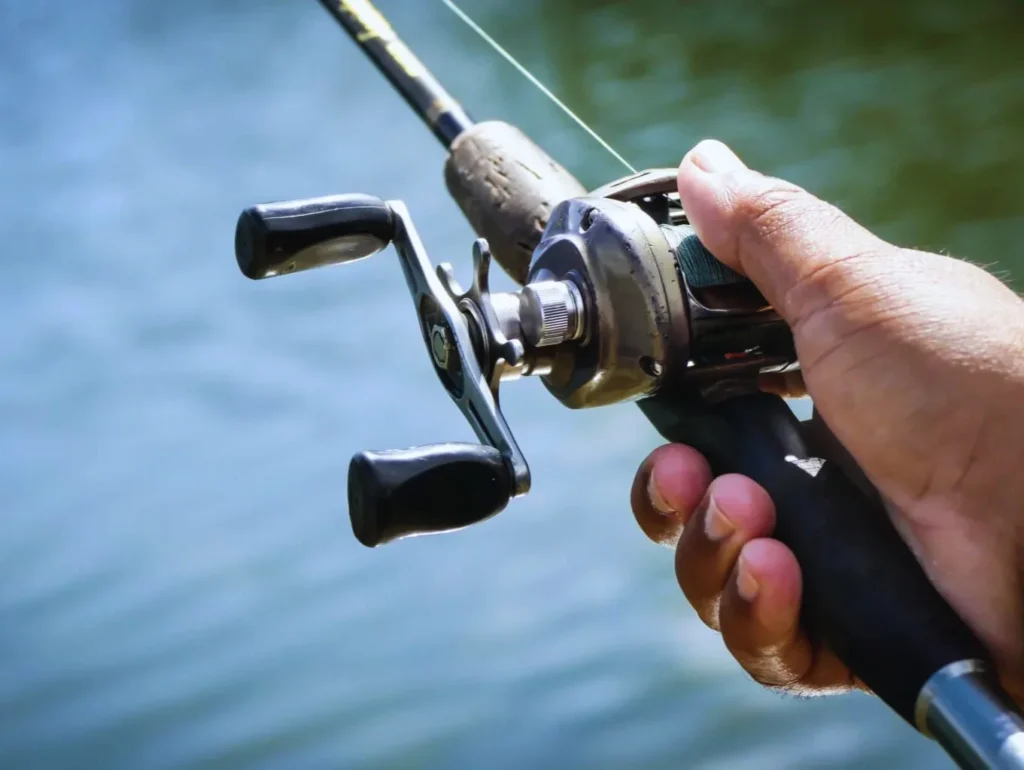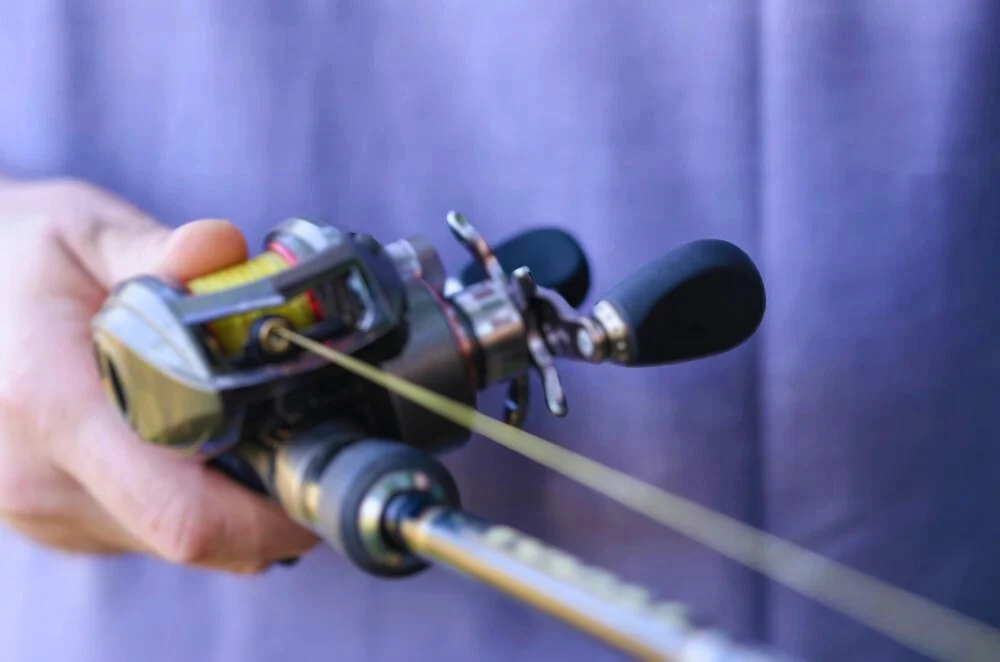
Hey, fellow fishers! Fishing is a love-level activity you relish, but specific terms confuse you, like gear ratio and how it is treated on a spinning or baitcasting reel.
Gear ratio matters. Do you agree with me? Let me explain. If you use a low-gear ratio reel for topwater fishing with buzzbaits and jerkbaits, your bait will be racing back to your boat like a sprinter on caffeine. Conversely, you will get lost presentations and missed opportunities if you try a high-speed gear ratio for low retrieve with crankbait or deep-diving lures. So, follow my unique guide on baitcaster gear ratio to become legendary in this field.
Baitcaster gear ratio explained
Baitcaster gear ratio means how many times the spool rotates with the whole turn of a handle for one time. If you put the case on an 8.1:1 gear ratio, the 8.1 shows the cranking of a spool eight times, while the right side of proportion (1) indicates the number of handle movements. What about a spinning reel? baitcaster reels typically have more speed ratio than spinning ones. Therefore, you can use a 10+ gear ratio for baitcaster reels. But, it never tells you have missed the fortuity to get a low-speed gear ratio—mainly, categorize the baitcaster gear ratio into three heads: slow, moderate, and fast.
Slow baitcaster gear ratio
Are you looking for a deliberate or unhurried retrieve? Choose a slow or low gear ratio that ranges between 5.0:1 to 6.9:1. Catching a big fish that demands more torque is possible with the low gear ratio as you need a low gear ratio when you move the bicycle paddle in a hilly place due to extra torque.
Application:
- Crankbait fishing: These less retrieval lines are tailor-made for crankbait fishing because when you want to maintain a consistent depth and control over the lures, you need low speed to perform that task.
- Swimbaits: The lures imitate underwater fish movement and entice predatory fish to catch more brilliant and prominent fish.
My tips:
A slow gear ratio means less speed but more torque. Here are some tips for better results.
- Firstly, anglers need to exercise patience because lure effectiveness lies in its slow movements for alluring a fish.
- Be smart while choosing a fishing line. I recommend using monofilament or fluorocarbon line because of its buoyancy and stretch to complement the slow presentations of finicky fish.
- Give some subtle twitches during the retrieve to feel the erratic movements of injured prey.
Medium baitcaster gear ratio
What is the best all-around gear ratio for a baitcaster reel? A medium gear ratio is the perfect blend of moderate speed and power to trigger a Bass, pike, or other freshwater fish that ranges between 6.9:1 to 7.9:1. I always keep the cranking speed low in case of aggressive fish and apply more torque to bring it out of water. It also works on covering water with efficient speed and torque to find out who is actively weeding fish.
Applications:
These gear ratios are like Swiss Army Knives to perform much work with one reel. That gear ratio works marvelously for Jigs and Texas-rigged worms to provide enough power to set the hook, Spinnerbaits to detect subtle strikes, shallow running lipless crankbaits, early season Swim Jigs, and Carolina rigs for bottom bouncing tactics.
My Tips
- It would help if you used medium gear ratio baitcaster reels on not very hot or too cold water but on fresh water because slow reels work best on cold water fishing, and high gear ratio reels work well on warmer water.
- Use popper, prop baits, or walking baits to entice the topwater strikes with this broad-spectrum gear ratio.
- Pay attention to the IPT (inches per turn)formula because only the gear ratio will never do everything for you. Fill up the spool with more monofilament lines, or buy a reel with a big spool to cover more lines to cast longer.
High baitcaster gear ratio
According to most anglers, any ratio that starts from 8.1:1 up to 10.1:1 is considered a high gear ratio. I suggest using a high-speed gear ratio if you want fast line retrieval, allowing your bait to hit the fish quickly and return to the boat. Trigger active and warm fish could be no incarnate task for bass anglers with a 9+ ratio.
Applications
Abu Garcia Revo Rocket Baitcasting reel (10.1:1) and Kastking Speed Demon (9.3:1) will be the best solution to perform these applications with such remarkable gear ratios.
- Flipping and pitching: When you are making cast undercover water like bushes, thick vegetation, docks, and brush piles, this game-changer gear ratio for flipping and pitching technique to get the fish out of the water swiftly. (Flipping is lowering the bait to fish under heavy cover, and pitching is casting on short distances up to 15-20 feet while making lure swings.)
- Topwater lures for schooling fish: High-speed gear ratios work sumptuously in top water presentations with lures like Buzzbaits, Hollow body frogs, Poppers, Reeling toads, and walking baits to provoke aggressive strikes. Schooling/ shoaling fish move together in the same direction or the same place, and you can hit them by using topwater lures with a high baitcaster gear ratio.
- Swim Jigs: High gear ratios work great when using swim jigs as they allow the bait to return quickly, like a lifelike swimming action to catch Salmon, Bass, Bluegill, Trout, etc.
- Spinnerbait or Chatterbait: Spinnerbait is an excellent option in muddy water. However, you can use it in clear or fresh running water, with the fundamental purpose of imitating fleeing prey. At the same time, Chatterbait is often profitable to use in cold and transparent water, and its vibration makes fish crazy to bite it. Hence, your target gets achieved.
My tips
- Keep the high gear ratio to perform only one technique. Switch between various methods, from topwater lures to soft plastic lures and jigging to flipping.
- I use a 7’4 heavy power Lew’s rod to pull the fish out of the water. I believe that pairing a high-power rod with a high baitcaster reel will be beneficial because I can set the hook, pull it hard, and give the fish more time to get the trigger from the heavy cover than use my high-speed reel when fish fight against me and put some torque on my rod too to pull the fish further that would be insurmountable with the low gear ratio and short rod.
- Choose a brightly-colored braided line that can make you see the line movement to hook the fast-action fish, but monitor your line regularly to check for any wear and tear, abrasion, or nicks.
Baitcaster gear ratio chart (explained)
The gear ratio of your baitcaster reel affects how you control the lure and how much power you have when reeling in a fish, but the ratio depends on lure types used, fishing styles, and fish’s behavior on the water. I collect these figures from multiple companies and present overall figures to clarify your idea before fishing in the water.
Gear Ratio | Description | Workable techniques | IPT | Drag power (lb) | When to use |
Slow gear ratio (5.0:1-6.9:1) | The handle moves slowly, which means less speed to get more torque/high resistance. | Crankbaits, Shaky head, and swimbaits. | 15-20 IPT | 10-15 Lb | Good in case of deep diving lures to catch sluggish fish. |
Medium gear ratio (6.9:1-7.9:1) | All around features of speed and power to do all fishing kinds. | Jigs, Worms, bottom dancing, and spinnerbaits. | 22-28 IPT | 12-20 lb | Versatile for various techniques. |
High gear ratio (8.1:1-10.1:1) | A high-speed line retrieval in the blink of an eye. | Flipping, pitching, and topwater fishing. | 28-45 IPT | 15-25 lb | When you want quick bait presentations. |
best gear ratio for baitcaster bass fishing

A bass is a tasty, oily fish of 25lb weight, and it can be fun to do bass fishing, but most anglers need clarification after knowing the gear ratio and are bewildered about what ratio they should use to catch a heavy bass. Rest assured. My advice is to choose a ratio between medium to fast from 6.9:1-9.3:1 because these fish hide under a thick cover, so you can use flipping, pitching, bottom dancing, or topwater techniques to persuade them to taste the bait.
What is the best baitcaster reel for bass fishing? I discovered from my Dad’s friend about Shimano SLX XT casting reel (that drag 12lb weight that become a good option for freshwater or surf water fishing to little extent) and Daiwa Tatula, Which I never use but get great comments from Jason and might think of using it.
I prepared a good, understandable table for you guys. Let’s have a look.
Bass fishing techniques | Baitcaster Gear ratio |
1- Crankbaits | 5.0:1-5.2:1 |
2- Spinnerbait | 6.1:-6.9:1 |
3- frog | 7.1:1-7.9:1 |
4- Carolina rigs | 6.1:1-6.9:1 |
5- Flipping and pitching | 7.9:1-8.1:1 |
6- Live bait | 6.5:1-6.9:1 |
Why is the baitcaster gear ratio slightly different from the spinning reel gear ratio?
A spinning reel is a beginner-friendly reel to tackle with lightweight. However, a baitcaster reel affords a better line to cast on long distances. What are the reasons behind the different gear ratios of spinning and baitcaster reels?
- Gear ratio and gear functionality are measured based on gear mechanism, and both have unique apparatus; the baitcaster has a spool that rotates perpendicular to the rod, while spinning rods have a fixed spool.
- Baitcaster reel is famous because of casting distance and speed and is run by an expert; therefore, they use a high gear ratio. But spinning reel is favored by expert level anglers over beginners, and consequently, they choose medium speed gear ratio.
- Matching your gear ratio with your selected lures and techniques would be best. If you own a baitcaster reel, you can use light and heavy lures with a slow to the high gear ratio, but in the case of a spinning reel, an angler uses light and small lures; hence, you have to choose low gear ratios.
Query Corner
What is the best gear ratio for a baitcaster?
Baitcaster gear ratio depends on fishing techniques, spool size, lure weight, water depth, and angler’s experience level, but I recommend a medium gear ratio of 7.1:-7.9:1 if you stepped newly to the fishing game, and you can win pike, Bass, Muskie, Trout, or any other fresh and saltwater fishes.
Can one reel handle all baitcaster gear ratios?
Yes! It can be worth attempting to use a moderate gear ratio of 7.1:1-7.9:1 to cover many fishing techniques and scenarios to maximize your triumph on water.
How does the drag power relate to the baitcaster gear ratio?
The drag system of a baitcaster reel does not directly sway the gear ratio but decides the reel’s power to control firm fish. The Gear ratio affects the retrieval speed, while the drag system influences a subtle pressure on a hooked fish.
To draw to a close
Baitcaster reels have a more substantial gear ratio as compared to spinning reels. Select your own choice and enjoy your journey on a fishing trip outside. I hope you have found this article a masterpiece of information.

2 thoughts on “Baitcaster gear ratio chart: How to choose best one”